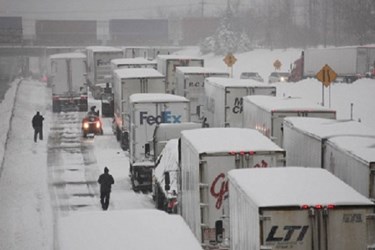Prepare Your Supply Chain For Extreme Weather
By Isaac Fletcher, contributing writer, Food Online

There is no escaping it, extreme weather events are going to happen whether you like it or not. However, with these events’ potential to disrupt supply chain operations, advance preparation will go a long way toward enduring the worst of sever-weather events.
One of the major 2015 trends impacting the global food and beverage industry is the growing rate of extreme-weather events. There were a handful of such events last year, and during the early parts of 2015, the industry has already had to endure events such as Blizzard Juno that pummeled the Northeastern U.S. While many of the dangers and threats caused by such events are very obvious, there are other issues that arise when extreme-weather events take place. One such issue is the impact these events have on the food supply of the affected region. For example, when a region that grows a tremendous amount of a particular crop becomes a victim of a severe-weather event, there are going to be issues throughout the supply chain when production of that crop drastically drops.
If a region becomes incapable of supplying the necessary volume of a specific food or crop as the result of weather-related issues, the global food and beverage supply chain is invariably impacted. This impact forces each organization that is connected to that supply chain to adapt and respond appropriately and effectively. Weather events that impact a certain crop or set of crops result in demand greatly outstripping supply, which means that those organizations throughout the supply chain that have effective strategies in place will suffer the least.
In order to develop such strategies, organizations should put the following safeguards in place:
Contingency Plans
It is important to know every point along the supply chain. In the event one of these critical links becoming temporarily disabled, there should already be a plan of action in place to mitigate the negative impact that follows. Some such plans include lining up secondary suppliers to fill the gap created by a primary supplier being disabled or having alternate shipping routes available in the case that weather makes traveling through a region dangerous or impossible.
Test Drills
Contingency plans can fall apart, even if they look perfect in theory. For this reason, it is imperative to run tests supply-chain contingencies. Using fabricated scenarios to play out the various effects of extreme weather will quickly reveal weak spots in a plan and allow them to be addressed before an actual event every materializes.
Underlying Technologies
Information technology (IT) has become a pivotal part of food and beverage supply chains and acts as the backbone for ensuring supply-chain operations run smoothly on a day to day basis. Accordingly, it is important to evaluate the technologies in place throughout the supply chain to determine if they are robust enough to keep operations running during extreme weather events. IT failures can quickly turn into loss of money, resources, time, and customers.
While it is obvious that weather conditions cannot be controlled, the proper preparation and planning can go a great way toward mitigating the negative supply chain impacts that come along with extreme weather events.
